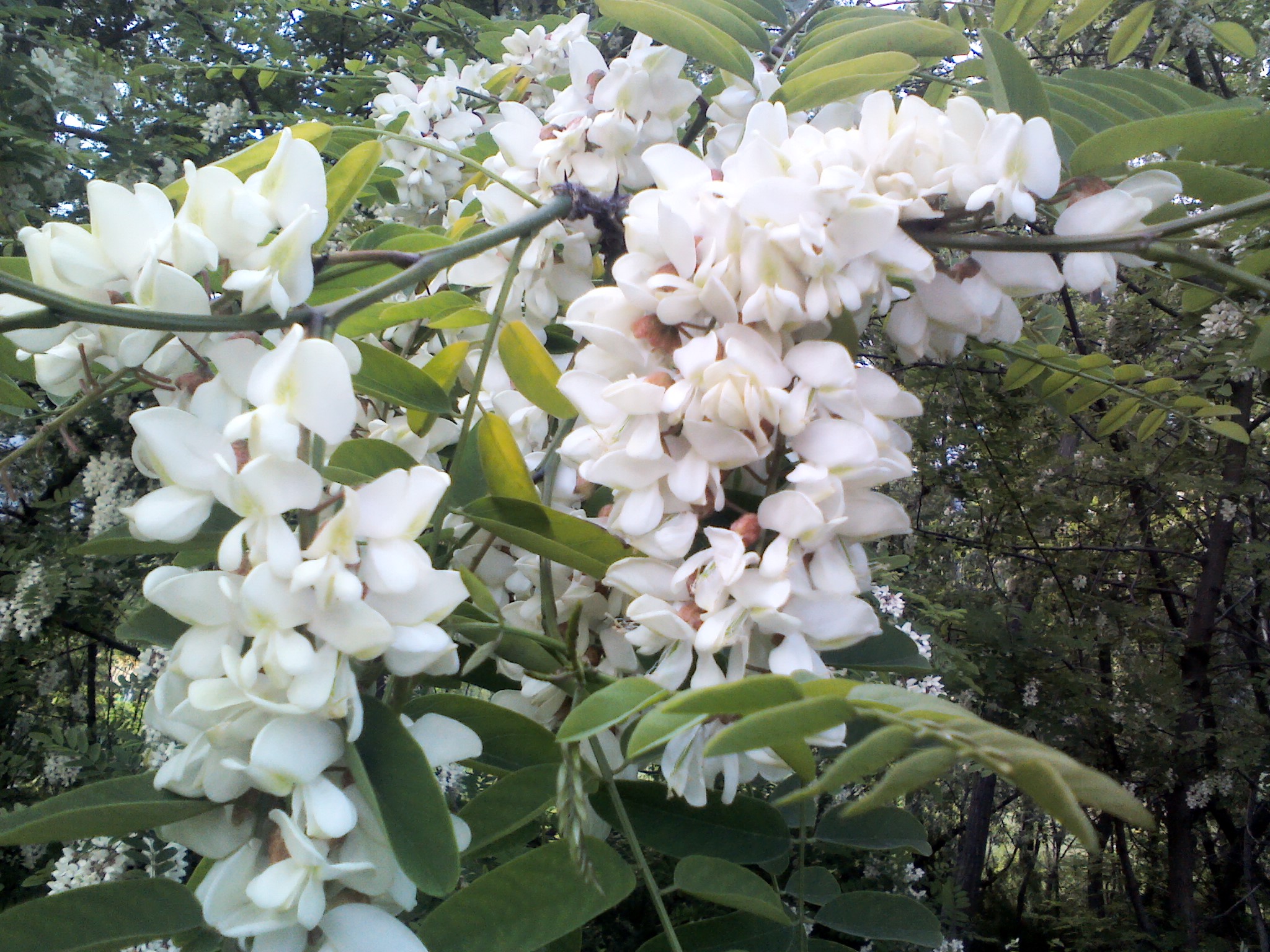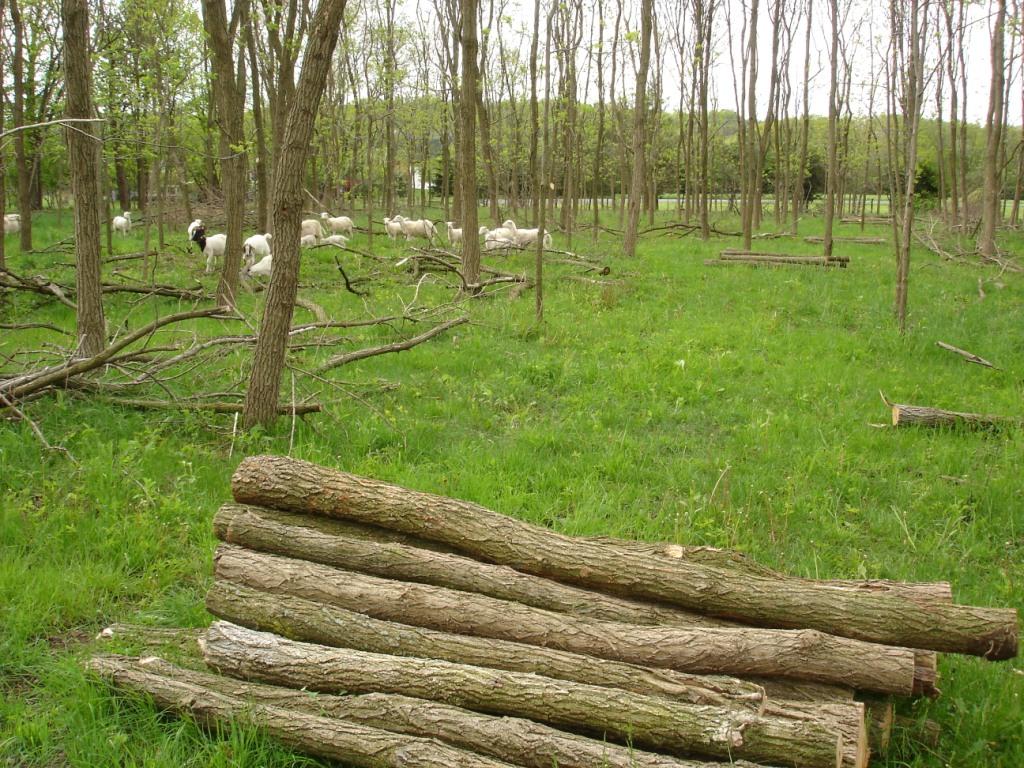A common, yet underappreciated tree that has great potential for farms across the Northeast: Black Locust (Robinia pseudoacacia).
This tree, which has often been given a bad name for its opportunistic rapid growth and robust thorns, is said to be native to the Appalachian Mountain range, though it has become naturalized throughout the United States, southern Canada, and even parts of Europe and Asia. The species is incredibly adaptive, growing in many elevations, microclimates, and soil types.
 Figure 1: These trees are over 20 feet tall just four years after planting
Figure 1: These trees are over 20 feet tall just four years after planting
While some have named it an “invasive” tree given its rapid growth and willingness to spread by seed and root suckering, others see these characteristics as advantageous, if populations are properly managed to harness these qualities. Make no mistake, locust is not a tree to plant and walk away from. It is best when incorporated into managed activities on the farm, of which there are a remarkable array of options and benefits, including:
- Windbreaks, shelterbelts, and shade and shelter for animals in silvopasture grazing systems, due to fast growth (3-4 feet per season) (Figure 1)
- Feed for ruminant livestock. The nutritional value of the leaves is similar to alfalfa (Baertsche and Hanover 1986). Some sources claim excessive consumption can lead to toxicity, but many farmers have found their animals naturally limit their intake (exception: horses).
- Nitrogen fixer: Barley grain crops interplanted with locust have higher nitrogen (Ntayombya and Gorden 1995), and black walnuts interplanted with locust as “nurse” trees were shown to rapidly increase their growth (Clark and Williams 1978).
- Food for honeybees. In Hungary, black locust is the basis of commercial honey production (Keresztesi 1977).
- High-density, rot resistant wood, ideal material for fenceposts, hope poles, outdoor furniture, decks, and other projects that require weatherproof materials (McLane 2004).
- Firewood. The BTU rating is among the highest, making it an excellent firewood in both heat value and coaling ability. At our last house, we actually ruined a woodstove by burning too much locust, which gets extremely hot.
 Figure 2: Black Locust flower produce high quality honey are edible, too!
Figure 2: Black Locust flower produce high quality honey are edible, too!
Some states prohibit importing, selling, or trading Black Locust, including Massachusetts and it is restricted in Minnesota, Michigan, and New York. This is not necessarily a complete list - check with your state regulators before deciding how to proceed. Each state has it’s own specific regulations.
Assuming you want to with Black locust, it’s important to consider the genetic stock you source trees from, especially if your goal is to grow straight poles or trees that can be milled for lumber. Locust is incredibly crooked in its “natural” form, and so seed selection, and sometimes pruning, is a critical factor for success. Ironically, the Hungarians identified the awesomeness of Black locust a long time ago in the 1700s (Rédei 2008), deciding to intentionally import seeds and engage in an intensive breeding program. As a result, some of the best stock today comes from Eastern Europe, and nearly 20% of the forests in Hungary are comprised of Black Locust (Keresztesik, 1983).
At our farm, Black locust has found a nice in our pastures, where it quickly establishes itself and is able to be integrated with our sheep grazing paddocks in under 5 years. We plant very close together (3 – 4 feet apart) so that over time, we can leave some trees as the overstory, while coppicing (cutting to the ground) and pollarding (cutting above browse height) the less straight ones to provide longer-term fodder reserves for the sheep. Eventually we can harvest some posts and poles, as well.
 Figure 3: Black Locust posts fetch a premium price and are in high demand on the market.
Figure 3: Black Locust posts fetch a premium price and are in high demand on the market.
With all its functions and uses in the farm landscape, it’s a wonder more people aren’t planting these trees, and managing ones they already have. The key take away is; if you plant it, manage it. This wonderful tree has many benefits to harvest, but left along could become a problem plant on the farm.
This excerpt is available for download in full at Wellspring Forest Farm’s website: http://media.wellspringforestfarm.com
References
Baertsche, S.R, M.T. Yokoyama, and J.W. Hanover (1986) Short rotation, hardwood tree biomass as potential ruminant feed-chemical composition, nylon bag ruminal degradation and ensilement of selected species. J. Animal Sci. 63:2028-2043.
Clark, Paul M., and Robert D. Williams. (1978) Black walnut growth increased when interplanted with nitrogen-fixing shrubs and trees. Proceedings of the Indiana Academy of Science, vol. 88, pp. 88-91.
Keresztesi, B. (1983) A breeding and cultivation of black locust, Robini pseudoacacia, in Hungary. Forest Ecology and Management. No. 19260. 1983.
Keresztesi, Béla. (1977) Robinia pseudoacacia: the basis of commercial honey production in Hungary. Bee World 58, no. 4: 144-150.
Ntayombya, P., & Gordon, A. M. (1995). Effects of black locust on productivity and nitrogen nutrition of intercropped barley. Agroforestry Systems, 29(3), 239-254.
Rédei, K., Osvath-Bujtas, Z., & Veperdi, I. (2008). Black locust (Robinia pseudoacacia L.) improvement in Hungary: a review. Acta Silvatica et Lignaria Hungarica, 4, 127-132.
